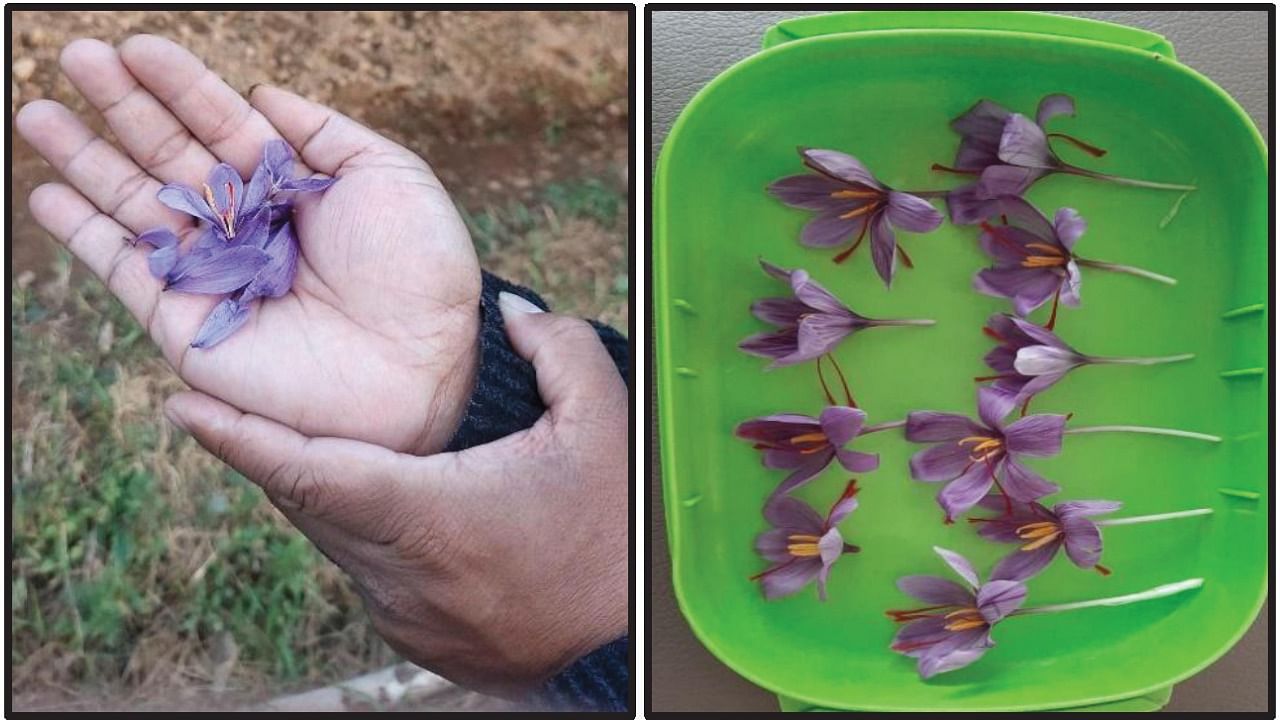
Cultivation of saffron, the costliest spice, is on its way from the "saffron bowl" Pampore in Kashmir to the country's Northeastern region.
After the success of a pilot under its Mission Saffron project in at least 17 high altitude locations in Arunachal Pradesh, Sikkim, Mizoram and Meghalaya, North East Centre for Technology Application and Reach (NECTAR), an agency under the Union ministry of science and technology has started work on first commercial cultivation of saffron in the Northeast.
"The trial cultivation in the four states was successful with good quality crops. About 1,000 farmers are now connected with us. We are planning in a big way this time and targeting to do commercial cultivation in 500 acres of land," director general of NECTAR, Arun Kumar Sarma told DH.
Locally called as kesar or zafran, the slender, reddish-brown flattened stigma of saffron flower it is also referred to as “red gold” due to its high cost and high demand. It is mostly used as medicines, in food, textiles and cosmetics. India consumes about 100MT of saffron annually but produces only 15 MT (2020-2021). The spice is cultivated mainly in Pampore district of Kashmir but efforts are now on to explore new areas of cultivation in order to bridge the demand-supply gap and thereby offer farmers with potential of a high value crop. Similar cultivation efforts are also underway in Himachal Pradesh and Uttarakhand.
Saffron is used as medicine to treat stomach disorders, bronchitis, asthma, diabetes, scarlet fever and cold, chronic uterine haemorrhage, amenorrhoea, dysmenorrhoea, smallpox and insomnia, cardiovascular disorders, said a report of the NECTAR.
"Our effort is to help farmers in the remote areas to go for commercial cultivation of the high value crops like saffron. This will not only increase their income but also push our local production," Krishna Kumar, a scientist with NECTAR said. "Post harvesting support and market linkages will also be provided to the farmers for maximum benefits," he said.
Conducive climate
The NECTAR said the dried stigmas of the saffron cultivated during the trials in the Northeast were tested and the results indicated that the soil and climate is conducive for commercial cultivation. "All the cultivation sites showed multiplication of daughter corms. This is a positive indication," said NECTAR. "Testing of the parameters such as colour and heavy metal content showed that the dried stigmas showed no sign of adulteration, and the presence of heavy metal was within the permissible limits," it said.
The trial cultivation was done in Chug, Dorjeeling, Shergaon and Walong in Arunachal Pradesh, Laitkor, Mairang, Nongshilliang, Thangsning, Umpling and Upper Shillong in Meghalaya, Ailwang, Lunglei and North Vanlaiphai in Mizoram and Lachung, Phengla, Sajong and Yuksom in Sikkim. Most of these places are situated on high altitudes. Farmers in those areas mainly grow paddy, millets, potato, kiwis, orange, plums, ginger, turmeric and other vegetables, at present.
Yuksom in Sikkim showed 100 per cent survival rate while Upper Shillong, Meghalaya showed the lowest survival rate (43.9 per cent). Dorjeeling in Arunachal Pradesh showed early flowering with the first flower blooming on October 12, 2022 compared to other cultivation sites where flowers bloomed during late October or early November. Highest flowering yield was observed in Umpling (4.22 per cent) followed by Thansning (4 per cent) and Nongshilliang (3.26 per cent) in Meghalaya. "The findings obtained can be good, and mass cultivation of saffron at the places with flowering yield >4 per cent could be suggested," NECTAR said.